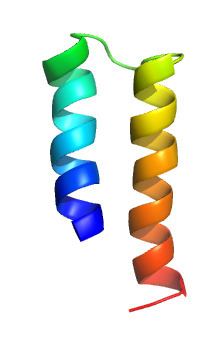Symbol MerF InterPro IPR021091 OPM superfamily 247 | Pfam PF11431 TCDB 1.A.72 OPM protein 2lj2 | |
 | ||
The mercury transporter superfamily (TC# 1.A.72) is a family of transmembrane bacterial transporters of mercury ions. The common origin of all Mer superfamily members has been established. The common elements between family members are included in TMSs 1-2. A representative list of the subfamilies and proteins that belong to those subfamilies is available in the Transporter Classification Database.
Contents
Subfamilies
Transport Reaction
The transport reaction catalyzed by Mer Superfamily members is:
Hg2+ or methyl-Hg2+ (out) → Hg2+ or methyl-Hg2+ (in)
MerF
The MerF protein encoded on plasmid pMER327/419 is an 81 residue polypeptide with two putative TMSs. It catalyzes uptake of Hg2+ in preparation for reduction by mercuric reductase. The MerF gene is found on mercury resistant plasmids from many gram-negative bacteria, but the sequence of the protein from these plasmids is the same. Limited sequence similarity is shown with the first two TMSs of MerT (TC# 1.A.72.3) and MerC (TC# 1.A.72.4). MerF has two vicinal pairs of cysteine residues which are involved in the transport of Hg(II) across the membrane and are exposed to the cytoplasm. Some members of the MerF family have been designated MerH.
Crystal structures
PDB: 1WAZ, 2H3O, 2LJ2, 2M67, 2MOZ
MerTP
The MerTP permeases catalyze uptake into bacterial cells of Hg2+ in preparation for its reduction by the MerA mercuric reductase. The Hgo produced by MerA is volatile and passively diffuses out of the cell. The merT and merP genes are found on mercury resistance plasmids and transposons of gram-negative and gram-positive bacteria but are also chromosomally encoded in some bacteria. MerT consists of about 130 amino acids and has 3 transmembrane helical segments. Evidence for direct interactions between the cytoplasmic face of MerT and the N-terminus of MerA have been presented. Operon analyses have been reported.
MerP
MerP is a periplasmic Hg2+-binding receptor of about 70-80 amino acyl residues, synthesized with a cleavable N-terminal leader. It is homologous to the N-terminal heavy metal binding domains of the copper-and cadmium-transporting P-type ATPases. The 3-D structure of MerP from Ralstonia metallidurans has been solved to 2 Å resolution (PDB: 1OSD). It is 91 amino acyl residues (aas) long with its leader sequence, is monomeric, and binds a single Hg2+ ion. Hg2+ is bound to a sequence GMTCXXC found in metallochaperones as well as metal-transporting ATPases. The fold is βαββαβ, called the ''ferridoxin-like fold''.
MerT
MerT homologues have been identified in which the 3 TMS MerT is fused to a MerP ''heavy metal associated'' (HMA) domain, possibly via a linker region that includes a fourth TMS (see 1.A.72.3.3). HMA domains of ~30 aas are found in MerP, copper chaperone proteins, mercuric reductase, and at the N-termini of both copper and heavy metal P-type ATPases, sometimes in multiple copies.
MerC
The MerC protein encoded on the IncJ plasmid pMERPH of the Shewanella putrefaciens mercuric resistance operon is 137 amino acids in length and possesses four putative transmembrane α-helical spanners (TMSs). It has been shown to bind and take up Hg2+ ions. merC genes are encoded on several plasmids of gram-negative bacteria and may also be chromosomally encoded. MerC proteins are homologous to other bacterial Hg2+ bacterial transporters.
MerE
The merE gene of transposon Tn21, a pE4 plasmid that contains the merR gene of plasmid pMR26 within Pseudomonas strain K-62, and the merE gene of Tn21 from the Shigella flexneri plasmid NR1 (R100) conferred hypersensitivity to CH3Hg2+ and Hg2+, taking up significantly more CH3Hg2+ and Hg2+ than the isogenic strain. The MerE protein encoded by pE4 was localized in the membrane cell fraction, but not in the soluble fraction. Kiyono et al. (2009) suggested that the merE gene is a broad mercury transporter mediating the transport of both CH3Hg2+ and Hg2+ across the bacterial membrane.
